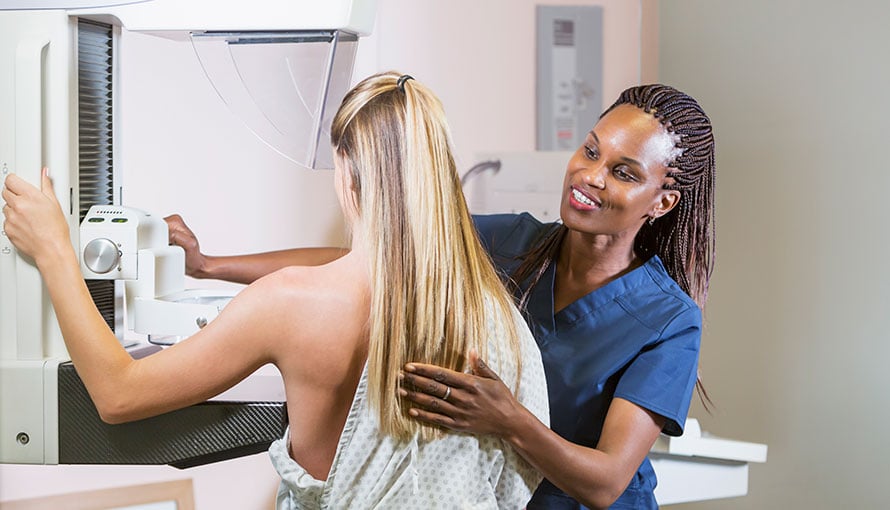What Does a Breast Cancer Lump Feel Like?

For many years, women were encouraged to perform monthly self-exams of their breasts, using their fingers to search for lumps that might be cancerous. Recent guidelines from the American Cancer Society (ACS) no longer recommend routine physical examination of the breast—either by a physician or the woman herself—as an effective breast cancer screening method. Instead, the ACS recommends that women rely primarily on regular mammogram screenings for early breast cancer detection, while also being aware of how their breasts normally look and feel so they can report any changes to their health care provider.
What does breast cancer feel like?
If you discover a lump in your breast or armpit area, it doesn’t necessarily mean you have cancer. In fact, there are quite a few common breast conditions that can cause cysts or other lump-like growths, and the vast majority of breast lump tissue that’s tested turns out to be benign (noncancerous). Even so, you should alert your doctor whenever you discover a lump in your breast.
It’s also important to consider that the symptoms of some forms of breast cancer don’t include lumps at all, so you’ll want to be aware of and on the lookout for symptoms that might indicate breast cancer.
What is the typical size and texture of a breast cancer lump?
In the early stages, most breast cancer lumps are too small to be detected by touch. In some cases, it’s possible to feel a breast cancer lump when it’s about a half-inch in diameter. But the ability to feel a lump can depend a great deal on where in the breast it’s located, the size of a woman’s breast, the density of her breast tissue and other factors. Generally, breast cancer lumps tend to feel hard, firm and solid, and they have irregular edges. However, it’s important to remember that some breast cancer lumps can be soft and smooth to the touch, so you should consult with your doctor whenever you feel a lump in your breast or armpit.
Do breast cancer lumps hurt?
Most breast cancer lumps don’t cause pain when you touch them. However, a malignancy in the breast can cause pain, discomfort and swelling in surrounding tissues.
Periodic breast pain is not unusual. In fact, many women experience changes in their breast tissue throughout their normal hormonal cycles, especially during the week that immediately precedes a menstrual period. During menstruation, it’s also common for both breasts to feel sore, tender or swollen. As long as your symptoms go away within a few days, you don’t need to be alarmed. However, if you experience sudden, severe breast pain or pain that persists for more than a few weeks, you should visit your doctor for a medical evaluation.
Do breast cancer lumps move?
Cancerous breast tumors tend to be fixed in place, but there are exceptions. So it’s always a good idea to check with your health care provider when you discover a breast lump.
Can breast cancer lumps be felt in an armpit?
A lump that’s found in an armpit is likely to indicate swelling of a lymph node, and such swelling is sometimes the result of breast cancer that’s spreading (metastasizing). This type of lump can also be found around the collarbone when a patient has breast cancer.
Can you have breast cancer without a lump?
Yes. Not only are many breast cancer lumps undetectable to the touch, but there’s a type of malignancy called inflammatory breast cancer (IBC) that often causes no tumor at all. The symptoms result from cancer cells blocking lymph vessels in the skin, a condition that leads to breast inflammation and symptoms such as redness and swelling. Fortunately, IBC is a rare form of breast cancer, accounting for only 1% to 5% of all breast cancers.
What does breast cancer look like?
Perhaps more important than checking your breasts for lumps is keeping an eye out for changes in the appearance of your breasts and reporting any worrisome symptoms to your doctor. Here are some of the symptoms that may indicate breast cancer, although they can also be signs of other common breast conditions:
- Swelling in your breasts or around your collarbone or armpits
- Dimpling and thickening of your breast skin
- Nipple retraction, redness, flaking, thickening or discharge
In addition to paying attention to any changes in the way your breasts look, you’ll also want to note any unusual sensations—such as burning, numbness or tingling—that persist for more than a few days.
When should you see a breast cancer specialist?
Even though most breast lumps are not cancerous, they should still be evaluated by a physician if they do not resolve on their own within a few days. This is also true for persistent breast pain and swelling, or changes in your breast’s appearance.
A medical professional can help you determine if any diagnostic tests, such as a CT scan or MRI, might be appropriate. At Moffitt Cancer Center, we offer a comprehensive range of diagnostic and preventive care services, including screening mammograms, which can often detect breast abnormalities before they can be discovered by touch or observed with the naked eye.

When should you start having screening mammograms?
The American Cancer Society recommends that women who have an average cancer risk and no breast cancer symptoms start receiving annual mammograms at age 40 if they want to. From age 45 to 54, women should get a mammogram every year. Starting at age 55, women have the option of continuing yearly screenings or switching to an every-other-year schedule. Whether women should continue having regular mammograms after age 75 is a question to be answered based on individual circumstances and consultations between the patient and her doctor.
If you’re having routine mammograms, it’s likely that any abnormal changes in your breast tissue will be detected before they progress to the point of becoming breast cancer lumps that can be felt through your skin. As breast cancer screening methods become more and more sophisticated, early detection rates continue to rise.
Why trust Moffitt for breast cancer screenings and treatment?
The Don & Erika Wallace Comprehensive Breast Program at Moffitt provides screening and treatment services to a high volume of patients each year. This means our multispecialty team has extensive experience in treating rare breast cancers as well as more common variants. What’s more, Moffitt is a designated Breast Imaging Center of Excellence, offering state-of-the-art mammography, breast ultrasound and breast magnetic resonance imaging (MRI), as well as stereotactic and ultrasound-guided core needle breast biopsy.
Our breast cancer program team comprises highly respected surgeons, medical and radiation oncologists and other practitioners who work exclusively with breast cancer patients to develop individualized therapy plans based on each patient’s condition and needs. Additionally, Moffitt patients often have access to innovative breast cancer treatment through the robust clinical trials program at our National Cancer Institute-designated Comprehensive Cancer Center.
At Moffitt, you are a top priority, and we’re committed to connecting you with a cancer expert as soon as possible. If you recently detected a lump in your breast and would like to have it evaluated by a medical professional, you can request a consultation at Moffitt by calling 1-888-663-3488 or submitting a new patient registration form online. We also offer screening mammograms that include advanced digital breast tomosynthesis (DBT or 3D mammography), and you don’t need a referral to visit our cancer center.
References
American Cancer Society – New Breast Cancer Screening Guidelines
Centers for Disease Control and Prevention – What Is Breast Cancer Screening?
MedicalNewsToday – Breast Cancer Signs & Symptoms
American Cancer Society – Breast Cancer Symptoms: What You Need to Know
